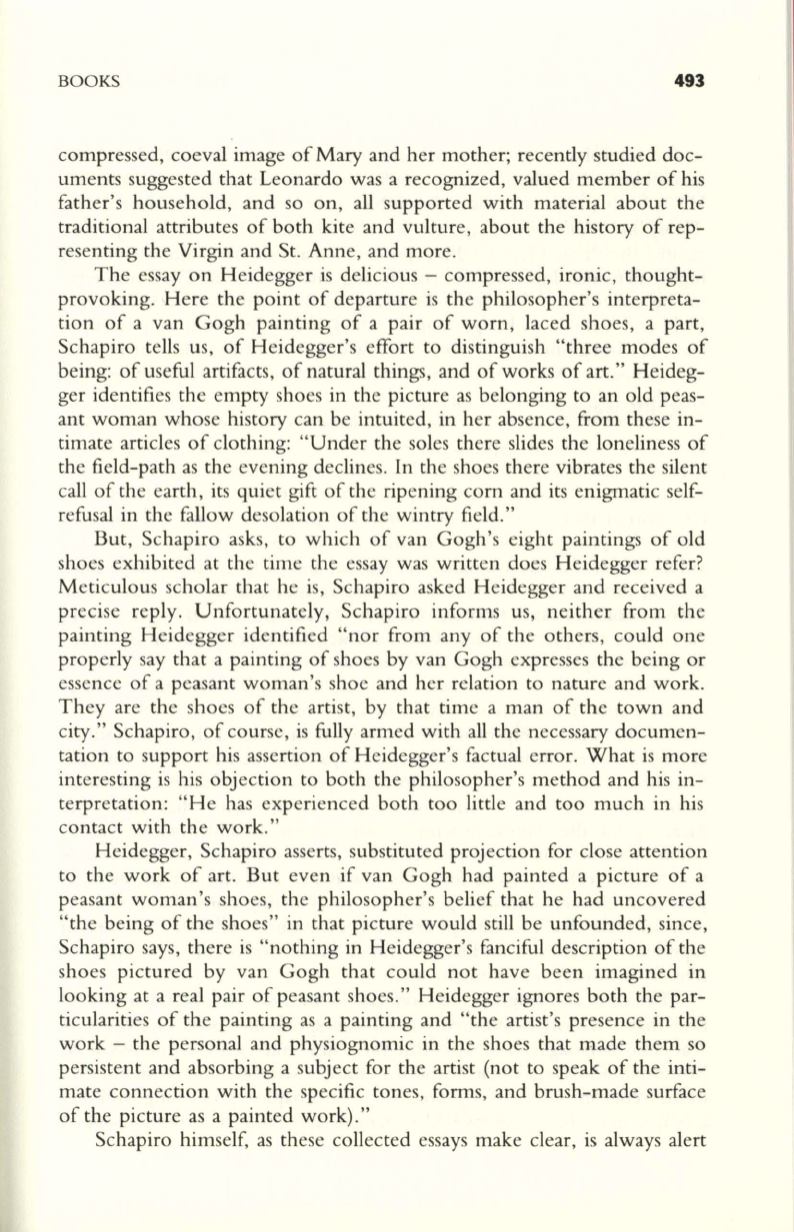
BOOKS
493
compressed, coeval image of Mary and her mother; recently studied doc–
uments suggested that Leonardo was a recognized, valued member of his
father's household, and so on, all supported with material about the
traditional attributes of both kite and vulture, about the history of rep–
resenting the Virgin and St. Anne, and more.
The essay on Heidegger is delicious - compressed, ironic, thought–
provoking. Here the point of departure is the philosopher's interpreta–
tion of a van Gogh painting of a pair of worn, laced shoes, a part,
Schapiro tells us, of Heidegger's effort to distinguish "three modes of
being: of useful artifacts, of natural things, and of works of art." Heideg–
ger identifies the empty shoes in the picture as belonging to an old peas–
ant woman whose history can be intuited, in her absence, from these in–
timate articles of clothing: "Under the soles there slides the loneliness of
the field-path as the evening declines. In the shoes there vibrates the silent
call of the earth, its quiet gift of the ripening corn and its enigmatic self–
refusal in the fallow desolation of the wintry field."
But, Schapiro asks, to which of van Gogh's eight paintings of old
shoes exhibited at the time the essay was written does Heidegger refer?
Meticulous scholar that he is, Schapiro asked Heidegger and received a
precise reply. Unfortunately, Schapiro informs us, neither from the
painting Heidegger identified "nor from any of the others, could one
properly say that a painting of shoes by van Gogh expresses the being or
essence of a peasant woman's shoe and her relation to nature and work.
They are the shoes of the artist, by that time a man of the town and
city." Schapiro, of course, is fully armed with all the necessary documen–
tation to support his assertion of Heidegger's factual error. What is more
interesting is his objection to both the philosopher's method and his in–
terpretation: "He has experienced both too little and too much in his
contact with the work."
Heidegger, Schapiro asserts, substituted projection for close attention
to the work of art. But even if van Gogh had painted a picture of a
peasant woman's shoes, the philosopher's belief that he had uncovered
"the being of the shoes" in that picture would still be unfounded, since,
Schapiro says, there is "nothing in Heidegger's fanciful description of the
shoes pictured by van Gogh that could not have been imagined in
looking at a real pair of peasant shoes." Heidegger ignores both the par–
ticularities of the painting as a painting and "the artist's presence in the
work - the personal and physiognomic in the shoes that made them so
persistent and absorbing a subject for the artist (not to speak of the inti–
mate connection with the specific tones, forms, and brush-made surface
of the picture as a painted work)."
Schapiro himself, as these collected essays make clear, is always alert


